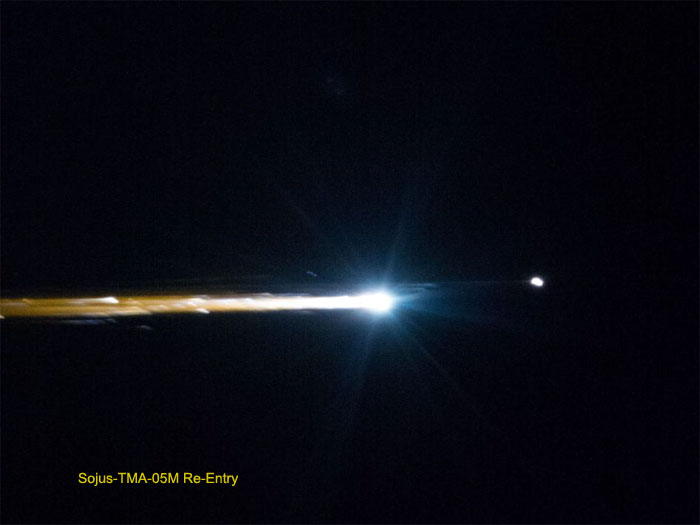.

DNA Can Survive Reentry from Space
Genetic blueprints attached to a rocket survived a short spaceflight and later passed on their biological instructions
.
If a cascade of meteors struck Earth billions of years ago, could they have deposited genetic blueprints and forged an indelible link between Earth and another planet?
Perhaps. Although that puzzling question remains unanswered, scientists have uncovered a new clue that suggests it is possible for DNA to withstand the extreme heat and pressure it would encounter when entering our atmosphere from space.
In a new study published today in PLOS ONE, a team of Swiss and German scientists report that they dotted the exterior grooves of a rocket with fragments of DNA to test the genetic material’s stability in space. Surprisingly, they discovered that some of those building blocks of life remained intact during the hostile conditions of the flight and could pass on genetic information even after exiting and reentering the atmosphere during a roughly 13-minute round trip into space.
The findings suggest that if DNA traveled through space on meteorites, it could have conceivably survived, says lead author Oliver Ullrich of the University of Zurich. Moreover, he says, “DNA attached to a spacecraft has the potential to contaminate other celestial bodies, making it difficult to determine whether a life form existed on another planet or was introduced there by spacecraft.”
The rocket test may fall short of representing the faster speed and higher energy of a meteor hurtling into our atmosphere, but it does suggest that even if the outside of a meteor was scorched, genetic material in certain places on the meteor could survive higher temperatures than scientists had previously realized and make it to Earth. The findings are “a stop on the way to understanding what the limits are for DNA’s survival,” says research scientist Christopher Carr of the Massachusetts Institute of Technology, who was not involved with the work but called the results “provocative.” The next steps, he says, would be to further pin down what temperature and pressure would ultimately kill DNA.
To test the effect of the hostile reentry conditions, Ullrich’s team embedded specially designed plasmid DNA — a circular thread of DNA that would not function if it were damaged and lost its loop shape — along the exterior of the craft in grooves and in the indentations of screw heads. Temperatures on the exterior of the rocket reached as high as 115.4 degrees Celsius during liftoff and 128.3 degrees Celsius during atmospheric reentry (by comparison, water boils at 100 degrees Celsius). Still, the plasmid DNA survived.
The researchers were intrigued to find that the DNA looked intact under a microscope. They also put some of the samples to work to see if the DNA remained functionally capable of passing on genetic instructions. The team exposed Escherichia coli bacteria to the space-traveling DNA. If the plasmid DNA were intact — as it proved to be — the E. coli would be able to take up the DNA, and that piece of genetic code would make the bacteria resistant to antibiotics. According to Ullrich, the researchers were surprised to find that the DNA passed on its information and the E. coli became drug resistant. The findings are “definitely exciting,” Carr says.
Earlier work had already revealed that certain bacteria could survive in space for prolonged periods despite intense ultraviolet and cosmic radiation, especially when they were partly shielded from such harmful rays by natural protectants like biofilm. Although those experiments suggested that certain hardy microbes could survive at least 1.5 years in space, there has been no firm evidence that DNA could also survive reentry.
In fact, in earlier experiments, bacteria and fungi did not survive after being embedded in rock samples mounted on the outside of a capsule and shot into space. The die-off in those experiments was due to damage on the DNA level, Ullrich’s team notes. The difference in this new work, Ullrich says, may have been the modicum of protection the DNA had due to its placement in grooves or screw heads. In the earlier experiments, reentry conditions had very high velocities and temperatures, and the protective layer from surrounding rocks was likely too thin to protect the microorganisms, he says. Indeed, researchers have never seen DNA survive reentry into the atmosphere until now, although one study did find that bacteria survived the reentry, disintegration and impact of the space shuttle Columbia.
This first evidence of plasmid DNA’s survival also suggests that in the future, DNA tests could be considered as a standard for measuring the effectiveness of decontamination procedures used in space programs. Returning spacecraft are routinely cleaned to protect Earth against the possibility of accidental contact with alien microbes.
In the larger picture, Carr says, the new study “gets us thinking what controlled experiments we should do to explore the limit for life and what the limit is for DNA.”
Quelle: SCIENTIFIC AMERICAN
5302 Views
